Lack of focus. Dizziness. Lack of balance. Hearing loss. Ringing in the ears. Vertigo can be a debilitating feeling that can significantly impact daily life.
Fortunately, the most common cause of vertigo—benign paroxysmal positional vertigo or, BPPV—can be easily treated with a repositioning maneuver. As an audiologist, I’ve worked with patients with various dizziness and imbalance disorders, including vertigo. Audiologists have extensive training in both the hearing and balance portions of the inner ear and are trained in diagnosing and treating inner ear dizziness. Vertigo can cause stress and anxiety, especially when experiencing it for the first time. This article will explore vertigo, its symptoms, and the testing and treatment options available.
What is vertigo?
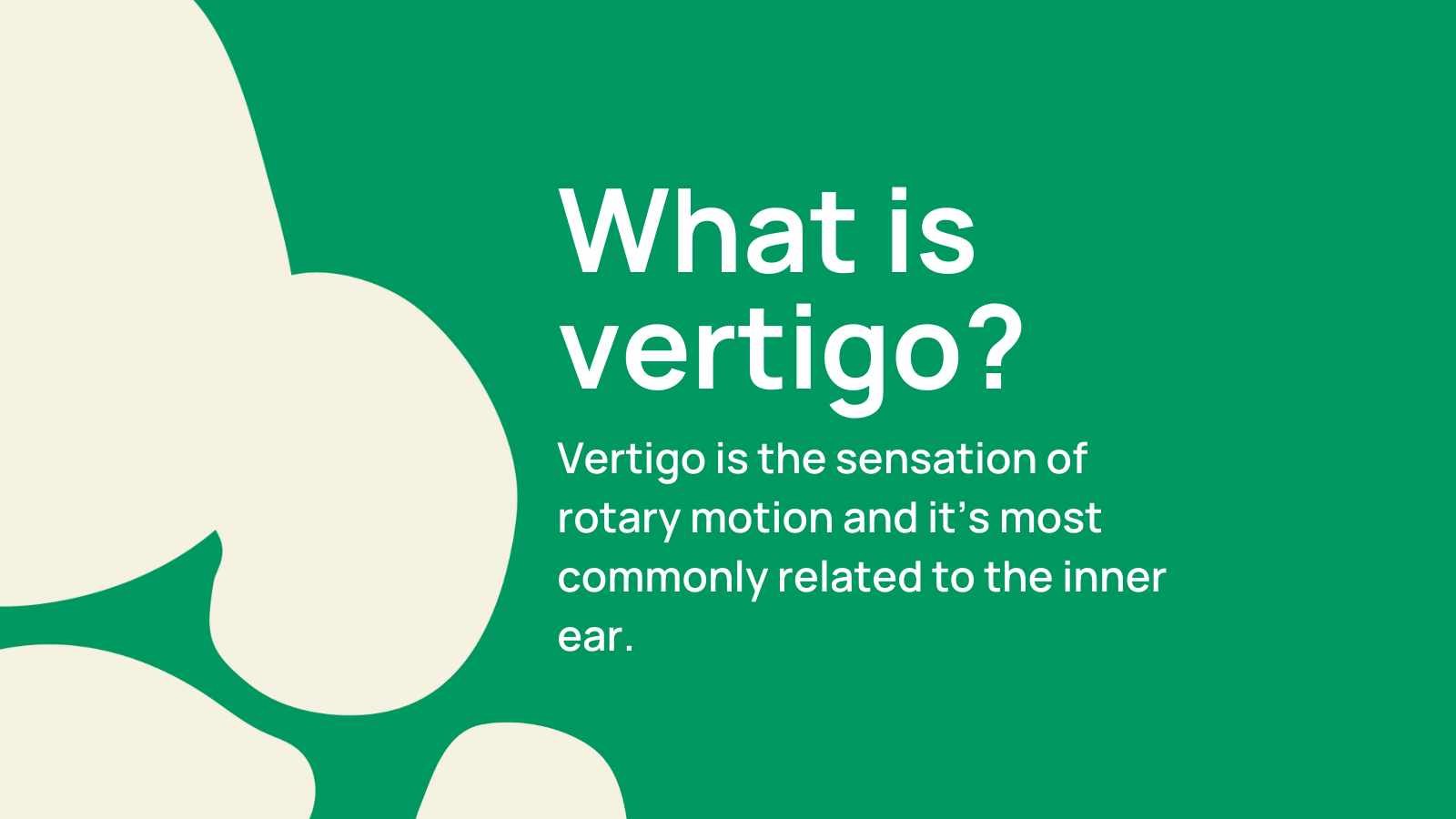
Vertigo is the sensation of rotary motion and it’s most commonly related to the inner ear. While this condition can occur at any age, it becomes more common with age and will affect 40% of Americans at least once in their lifetime. It can come on suddenly or be triggered by head turns or movement. Vertigo is a symptom and can have a variety of causes of peripheral or central origin.
Peripheral Vertigo
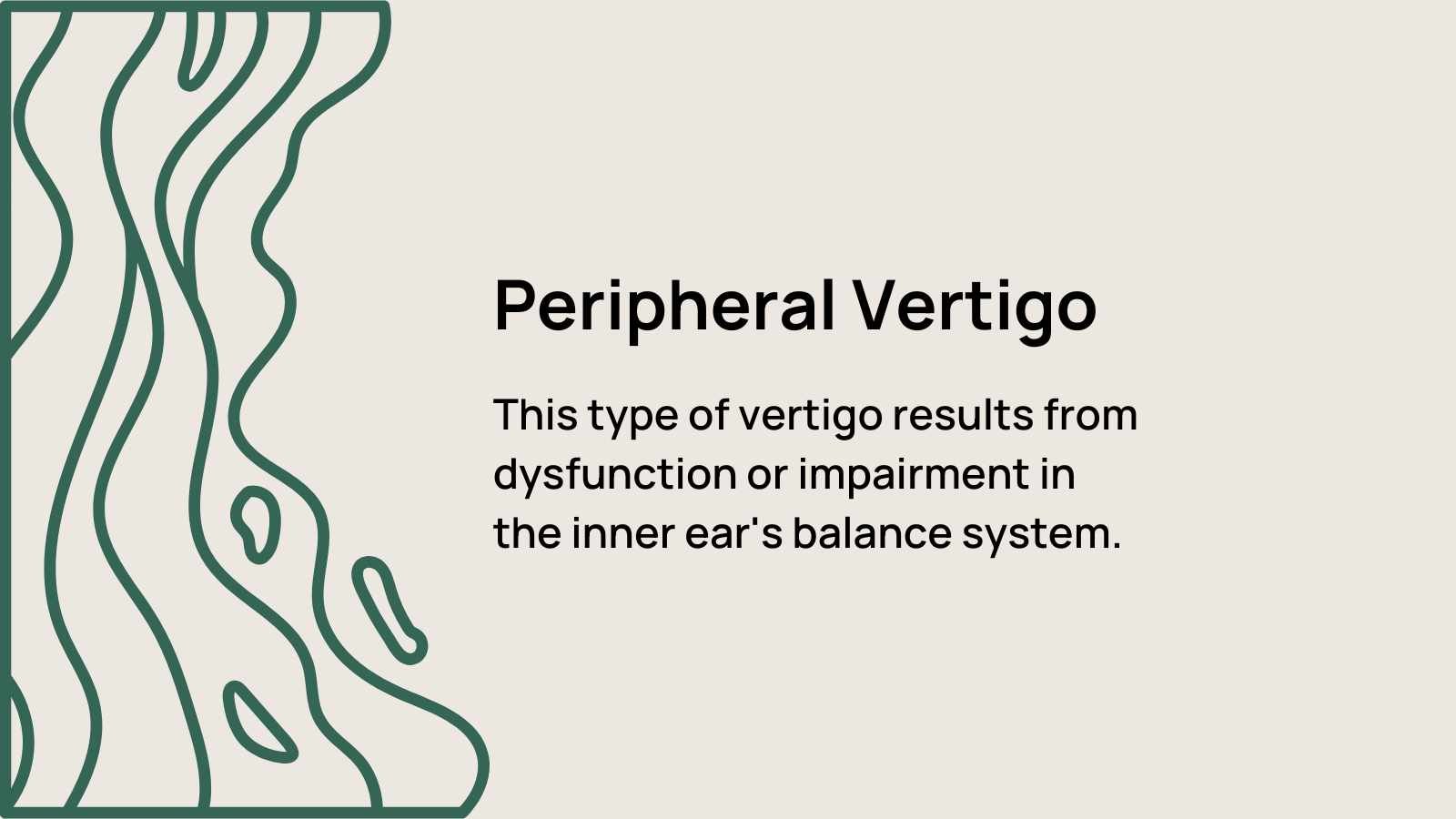
This type of vertigo results from dysfunction or impairment in the inner ear's balance system. The inner ear has three balance canals (semicircular canals), an organ that detects horizontal motion (the utricle), and an organ that detects vertical motion (the saccule). Various conditions can affect one or more balance organs in the inner ear, leading to vertigo. Benign paroxysmal positional vertigo (BPPV) is one of the most common causes of vertigo and happens when a tiny "crystal" (otoconia) migrates into one of the balance canals and causes the ear to perceive motion.
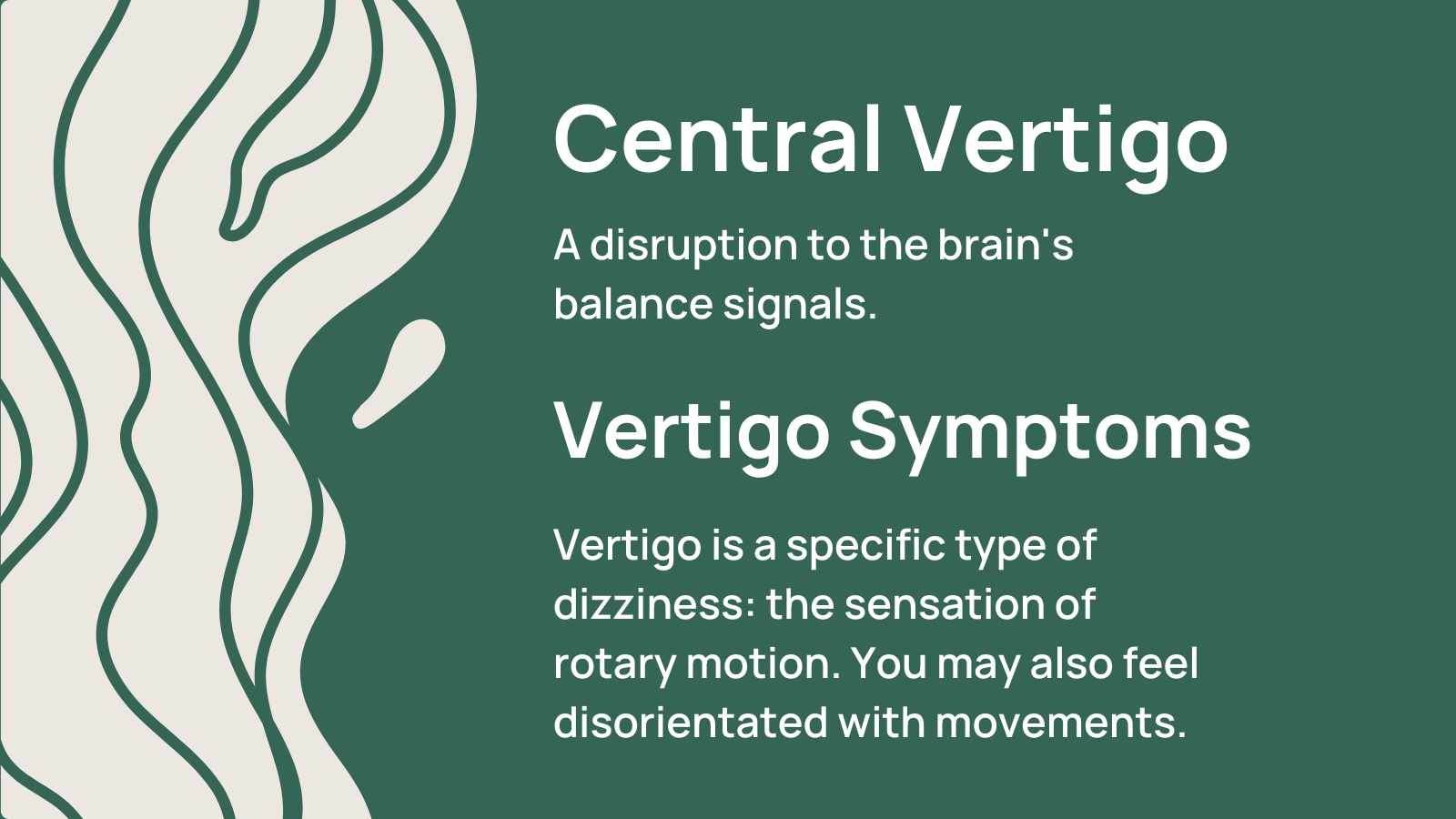
Central Vertigo
When there is a disruption to the brain's balance signals, it creates the sensation of vertigo. Causes can include stroke, brain injury, or certain types of infections.
Vertigo Symptoms
Dizziness can include various sensations, such as lightheadedness, imbalance when walking or standing, or unsteadiness. However, vertigo is a specific type of dizziness: the sensation of rotary motion. You may also feel disorientated with movements such as tilting your head, moving your eyes around, or sitting up after lying down. In some cases, nausea and vomiting may also occur due to the sensation of motion. These symptoms can be stressful, especially when they happen unexpectedly. If you have these symptoms frequently or it lasts an extended period, it is essential to seek medical attention.
What is happening in the body?

Various factors, such as inner ear disorders, migraines, or head injuries, can cause vertigo. While most forms of vertigo relate to the inner ear (peripheral vertigo), some are due to central causes. These factors can interfere with the body's balance mechanism, known as the vestibular system, causing the symptoms.
Think of our balance system like a three-legged stool consisting of:
- Vision
- Proprioception (awareness of the position and movement of the body)
- Inner ear (vestibular system)
Each leg is vital to keep us in balance, correctly orient ourselves in space, and walk on static or dynamic surfaces. We use our visual surroundings to orient us to cues about our environment.
For example, our eyes tell us whether our environment is stationary or in motion. If you've tried to read a book while in a moving car, you may notice motion sickness or nausea, which usually subsides once you keep your eyes on the road.
This motion sickness or discomfort results from a mismatch between the eyes and the inner ear's perception. Proprioception gives us cues about our environment through our ankle angle or other proprioception cues through physical touch.
What is the most common cause of vertigo?

Benign paroxysmal positional vertigo (aka, BPPV) is the most common cause of vertigo. One study estimated that approximately 52% of vertigo is diagnosed as BPPV. While the cause of BPPV is not always known, it becomes more likely with age, head trauma, and vitamin D deficiency.
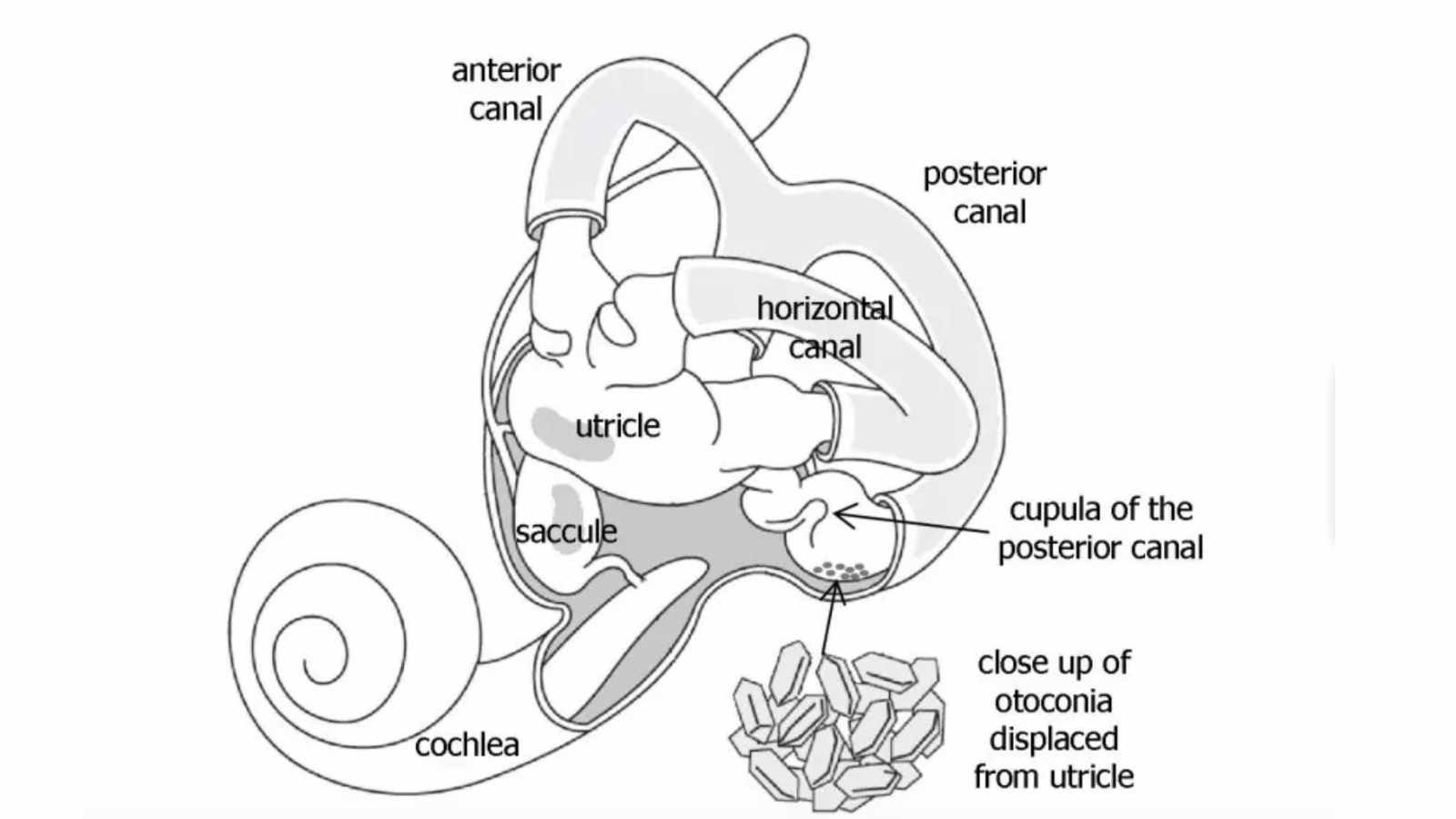
The ear has several different parts:
- The ear canal is where we can have wax build-up
- At the end of the ear canal is the eardrum
- Behind the eardrum is the middle ear (where we can get fluid from an ear infection)
- The inner ear is located behind the middle ear (made up of two parts: one for hearing and one for balance)
In a normal vestibular system, head movement triggers an excitatory response toward the direction of the movement. So, for example, when you turn your head to the right, the right ear registers an excitatory response, and the brain receives the signal that the head is turning, prompting a counter reaction from the eyes to keep your gaze steady.
BPPV happens when a small particle (otoconia) dislodges from the utricle in the balance portion of the ear and floats into one of the balance canals (posterior, anterior, or horizontal canals). Sometimes this particle is reabsorbed by the body without needing treatment, and vertigo dissipates.
The good news is that whether the particle dissolves or not, this condition does not damage the ear. However, it needs to be put back in place, like guiding a marble through a maze. A repositioning maneuver clears the particles and resolves vertigo in 90% of cases.
Vestibular Assessment

Depending on your symptoms, additional testing may be required to assess your vestibular system fully. Some assessment tools may include:
- Dix-Hallpike Maneuver
- Head Impulse Test
- Videonystagmography (VNG)
- Posturography
- Vestibular Evoked Myogenic Potential (VEMP) testing
Dix-Hallpike Maneuver
During this test, the doctor will ask you to sit upright on an exam table and turn your head to the right. Then you'll lie down on your back, keeping your right ear down at a 45-degree angle. The same procedure is repeated on the left side. Next, the doctor will watch your eyes for nystagmus (quick, jerking eye movements). If this maneuver prompts vertigo, the posterior semicircular canal requires repositioning to clear the otoconia.
Head Impulse Test
This test assesses the vestibular ocular reflex (VOR), checking for corrective eye movements with changes in head position. The examiner will ask you to focus on a target, such as the bridge of your nose, while making sudden, quick movements of your head. Alternatively, this test can be performed while wearing goggles and staring at a target. When the normal, corrective eye movements are delayed or absent, the results suggest a weakness in one ear's balance system.
Videonystagmography (VNG)
During this test, you'll wear a pair of goggles and do various tasks, such as watching a red light, sitting or lying in different positions, and keeping your eyes open while warm or cool air (or water) is placed in the ear canal. This test assesses the inner ear's balance system by monitoring eye movements.
Posturography
This test challenges the balance system by evaluating input from the vestibular, visual, and proprioceptive systems. You'll do this assessment by standing on a platform and keeping your balance while keeping your eyes open, closing your eyes, balancing on a moving platform, and while your surroundings move.
Vestibular Evoked Myogenic Potential (VEMP) Testing
Two tests (cVEMP and oVEMP) assess the utricle and saccule. This testing involves wearing some stickers while lying on a table, listening to clicking sounds, and either lifting your neck off the table or moving your eyes toward the ceiling.
- Position yourself on a bed with your legs out in front of you while sitting upright with your head turned over your right shoulder.
- Lie back on the bed, turning your head toward your right shoulder. (You can position a pillow below your shoulders for comfort.) If you experience vertigo in this position, wait until it stops, and then wait an additional 30 seconds.
- Turn your head over your left shoulder while keeping your body in the same position.
- Keeping your head in the same position, roll onto your left side as you look towards the floor. Wait for any symptoms to subside, and then wait an additional 30 seconds.
- Push yourself up to a seated position with your right hand, slowly bringing your head level with the horizon. Wait in this position for any symptoms to subside.
Steps to follow for the left ear:
- Position yourself on a bed with your legs straight out in front of you while sitting upright with your head turned over your left shoulder.
- Lie back on the bed, keeping your head turned toward your left shoulder. (You can position a pillow below your shoulders for comfort.) If you experience vertigo in this position, wait until it stops, and then wait an additional 30 seconds.
- Turn your head over your right shoulder while keeping your body in the same position.
- Keeping your head in the same position, roll onto your right side as you look towards the floor. Wait for any symptoms to subside, and then wait an additional 30 seconds.
- Push yourself up to a seated position with your left hand, slowly bringing your head level with the horizon. Wait in this position for any symptoms to subside.
What treatment options are available?
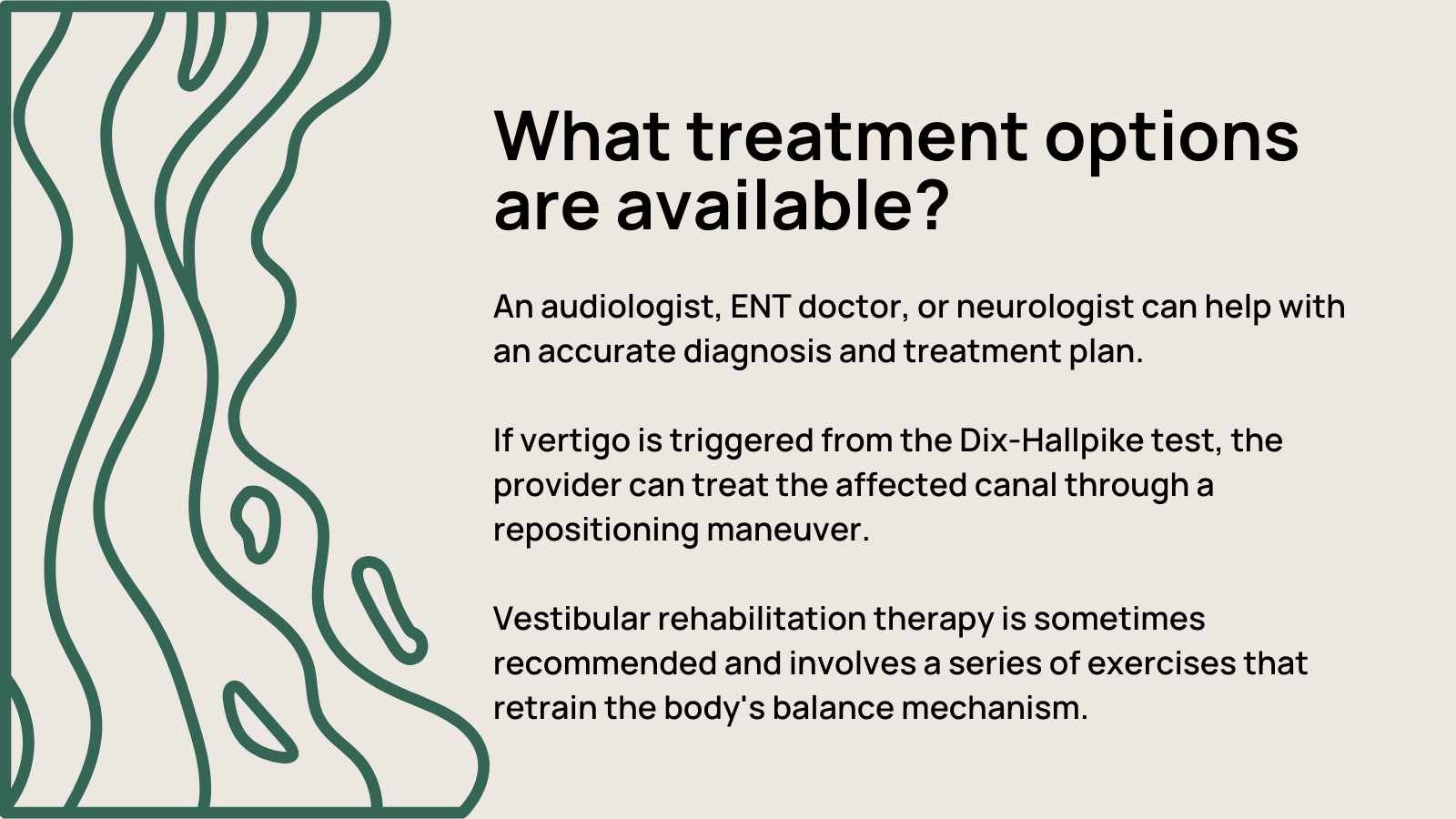
Treatment options depend on the underlying cause of vertigo or dizziness, and a proper assessment is a crucial step to determine the best treatment course. An audiologist, ENT doctor, or neurologist can help with an accurate diagnosis and treatment plan.
Most commonly, if vertigo is triggered from the Dix-Hallpike test, the provider can treat the affected canal through a repositioning maneuver. If BPPV is ruled out as a cause of vertigo, other tests help for further assessment, including hearing evaluation, physical examination, and imaging studies.
Vestibular rehabilitation therapy (VRT) is sometimes recommended and involves a series of exercises that retrain the body's balance mechanism. VRT can be done with a trained professional and customized to suit your needs.
At Home Treatments

If you have BPPV and have previously been treated, a professional may advise a maneuver to help treat a recurrence of vertigo. These maneuvers involve specific head and body movements to reposition the tiny crystals in the inner ear that cause miscommunications between the balance receptors.
In order to properly treat vertigo, it is essential to know which balance canal in which ear is affected and, thus, which maneuver will help. So for anyone experiencing vertigo for the first time, please see a professional first to determine the cause of the vertigo.
If your vertigo is caused by something other than BPPV, the maneuvers will not resolve your vertigo. Additionally, if you do a repositioning maneuver that targets a canal other than the affected balance canal, the crystals can migrate to a different canal, which can worsen vertigo rather than improve it.
One maneuver, called the Epley maneuver, is highly effective at treating most BPPV. This maneuver involves a sequence of head movements. Doing it as instructed is essential; if done correctly, you may feel better after the first attempt.
Epley Maneuver
The most common balance canal affected is the posterior canal, treated with the Epley maneuver. Approximately 85 - 95% of BPPV sufferers have particles in the posterior canal.
These are the steps involved in this maneuver for the right ear:
.jpg)
- Position yourself on a bed with your legs out in front of you while sitting upright with your head turned over your right shoulder.
- Lie back on the bed, turning your head toward your right shoulder. (You can position a pillow below your shoulders for comfort.) If you experience vertigo in this position, wait until it stops, and then wait an additional 30 seconds.
- Turn your head over your left shoulder while keeping your body in the same position.
- Keeping your head in the same position, roll onto your left side as you look towards the floor. Wait for any symptoms to subside, and then wait an additional 30 seconds.
- Push yourself up to a seated position with your right hand, slowly bringing your head level with the horizon. Wait in this position for any symptoms to subside.
Steps to follow for the left ear:
- Position yourself on a bed with your legs straight out in front of you while sitting upright with your head turned over your left shoulder.
- Lie back on the bed, keeping your head turned toward your left shoulder. (You can position a pillow below your shoulders for comfort.) If you experience vertigo in this position, wait until it stops, and then wait an additional 30 seconds.
- Turn your head over your right shoulder while keeping your body in the same position.
- Keeping your head in the same position, roll onto your right side as you look towards the floor. Wait for any symptoms to subside, and then wait an additional 30 seconds.
- Push yourself up to a seated position with your left hand, slowly bringing your head level with the horizon. Wait in this position for any symptoms to subside.
Following a repositioning maneuver, it is normal to feel a bit wobbly. This sensation usually resolves within several hours of successful repositioning or up to one day afterward.
Final Thoughts
Vertigo can be unsettling, but fortunately, the most common cause of vertigo is easily treated. Nevertheless, if you experience vertigo, it's essential to understand the underlying cause and seek medical attention to determine the cause and appropriate treatment. You can also try simple maneuvers to help ease symptoms while waiting for medical attention. Remember, audiologists are trained professionals who specialize in balance disorders and can offer both hearing and balance assessment and treatments.






